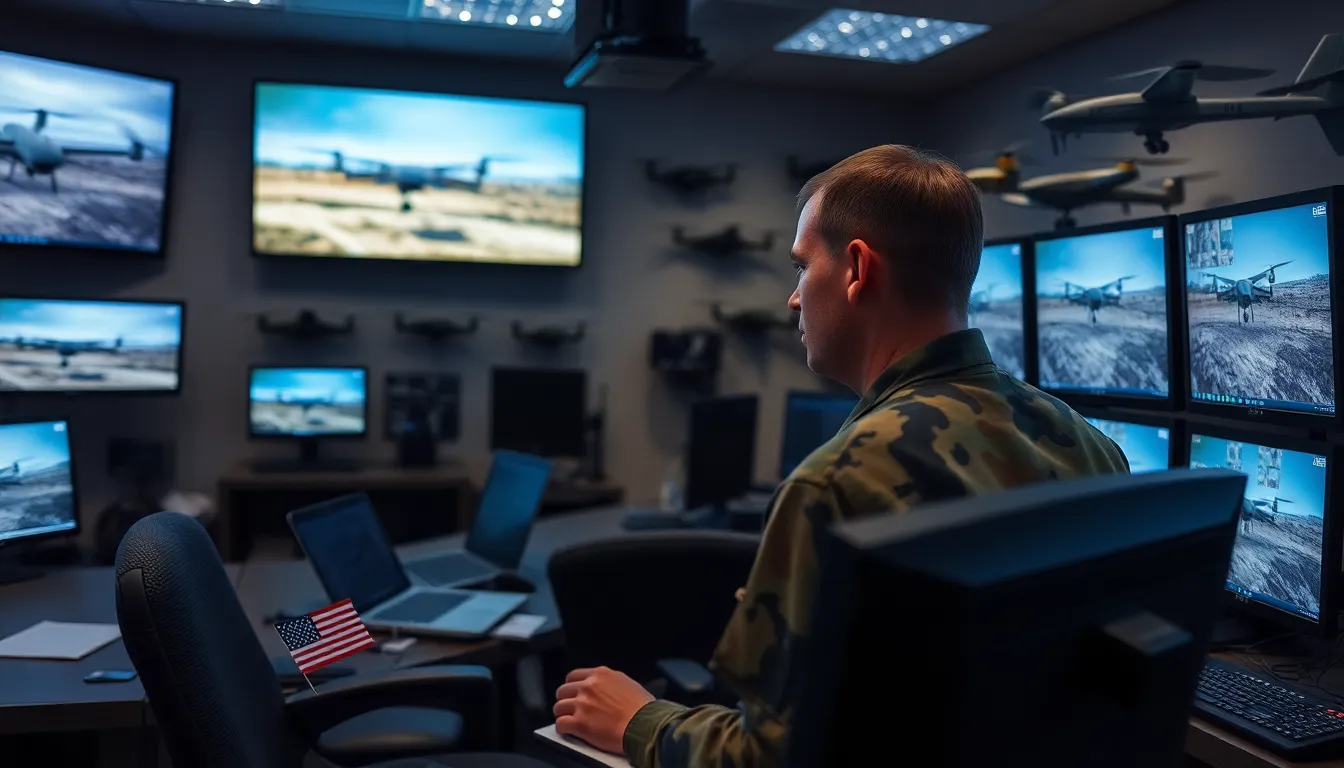In a world where technology often feels like it’s straight out of a sci-fi movie, military drones have taken center stage, proving that the future is now. These high-flying marvels aren’t just for surveillance; they’re redefining modern warfare as we know it. Imagine sending a drone to do the dirty work while you kick back and sip your coffee. Sounds like a dream, right?
But it’s not all fun and games. Military drones come with serious implications that go beyond just cool gadgets. They’re changing strategies, enhancing precision, and raising ethical questions faster than you can say “drone strike.” As nations race to dominate the skies, understanding the role of these aerial wonders becomes crucial. Buckle up as we dive into the fascinating world of military drones, where innovation meets responsibility in the most unexpected ways.
Table of Contents
ToggleOverview of Military Drones
Military drones have become essential tools in modern warfare, bridging traditional combat methods and advanced technology. These unmanned aerial vehicles (UAVs) serve various purposes, enhancing military capabilities globally.
Types of Military Drones
Reconnaissance drones focus on surveillance, collecting intelligence in real time. Combat drones engage directly in missions, delivering precision strikes against targets. Targeting drones assist ground forces by providing aerial imagery and supporting real-time decision-making. Development of unmanned combat aerial vehicles (UCAVs) continues, offering innovative solutions for complex operations. Each type of drone plays a unique role, enhancing the effectiveness of military strategies.
Uses of Military Drones
Military forces utilize drones for surveillance missions, enabling them to monitor enemy movements without risking personnel. Precision targeting reduces collateral damage, making strikes more effective. Logistics support, such as delivering supplies and equipment, leverages drones to maintain operational efficiency. Additionally, training programs increasingly incorporate drones, preparing soldiers for future conflicts. The multifunctionality of drones transforms the battlefield, allowing armed forces to adapt swiftly.
Advantages of Military Drones

Military drones offer various advantages that significantly enhance combat effectiveness and efficiency. Emphasis on several key aspects highlights their impact on modern warfare.
Cost-Effectiveness
Cost savings represent a crucial advantage of military drones. They reduce operating expenses compared to traditional aircraft. Maintenance costs for drones are generally lower, given fewer mechanical components. Additionally, fewer personnel are required for operations, reducing training and salary expenses. Drones enable extended missions without risking human lives, which can lead to substantial cost reductions in logistics. Procurement costs for drones can also be less than those of manned aircraft, making them financially viable for many military forces.
Operational Efficiency
Operational efficiency embodies another significant advantage of military drones. These UAVs can conduct surveillance for extended periods without fatigue, collecting critical intelligence data. Drones often possess the ability to operate in hostile environments where manned aircraft cannot. Precision targeting capabilities lead to reduced collateral damage during strikes, which enhances mission effectiveness. The deployment of drones also enables faster response times to emerging threats. Factors such as remote operation further allow personnel to control missions from safer locations, ensuring the safety of military personnel.
Challenges and Concerns
Military drones present a range of challenges and concerns that require consideration. These issues span ethical implications and security risks critical to the future of drone technology.
Ethical Considerations
Ethical dilemmas emerge from the use of military drones in warfare. Critics frequently highlight the potential for collateral damage, raising questions about the morality of remote strikes. Loss of civilian life can occur in aerial operations, leading to calls for stricter operational protocols. Accountability for drone strikes remains ambiguous, complicating legal responsibilities and international laws. Moreover, the psychological impact on operators and affected populations needs examination, as detachment from physical combat may alter perceptions of warfare. Growing reliance on drones can desensitize military personnel and the public to the realities of conflict, contributing to an overall decline in human empathy.
Security Risks
Security risks associated with military drones are significant and multifaceted. Unmanned aerial vehicles (UAVs) can become targets for hacking and cyberattacks, compromising sensitive operations. The potential for adversaries to capture and exploit military drones raises alarms about intelligence leakage. Additionally, the proliferation of drone technology among non-state actors presents a growing threat. These entities could deploy drones for hostile actions, making it challenging to distinguish between combatants and civilians. Furthermore, increased drone usage may escalate arms races in warfare, prompting nations to enhance their military capabilities.
Future of Military Drones
Technological advancements continue to shape the future of military drones. Integration of artificial intelligence enhances decision-making processes, allowing drones to analyze environments and identify targets autonomously. Innovations in materials science improve durability and reduce weight, extending flight durations and operational ranges. Enhanced sensors provide better surveillance capabilities, leading to clearer images and more accurate intelligence. Furthermore, advances in communication systems facilitate real-time data sharing, improving coordination among military units.
Potential regulations will play a critical role in the deployment and use of military drones. Countries are contemplating policies to ensure responsible usage and mitigate ethical concerns associated with drone warfare. International agreements may set guidelines for UAV operations in combat situations, aiming to reduce collateral damage. Implementing limiting measures could address accountability for actions taken by drones, clarifying responsibility in case of civilian casualties. Developing frameworks for drone technology will be essential as nations navigate security risks while seeking to capitalize on the tactical advantages drones provide.
Military drones are reshaping the landscape of modern warfare by enhancing operational efficiency and redefining strategic approaches. Their ability to conduct surveillance and execute precise strikes without risking lives marks a significant shift in combat dynamics. As nations increasingly rely on these technologies, the balance between tactical advantages and ethical considerations becomes crucial.
Navigating the challenges posed by security risks and the potential for misuse will require a thoughtful approach to regulation and accountability. The future of military drones hinges on continued technological advancements and the establishment of frameworks that ensure responsible use. As the dialogue around these unmanned systems evolves, it’s clear that military drones will remain a pivotal element in the ongoing transformation of warfare.









